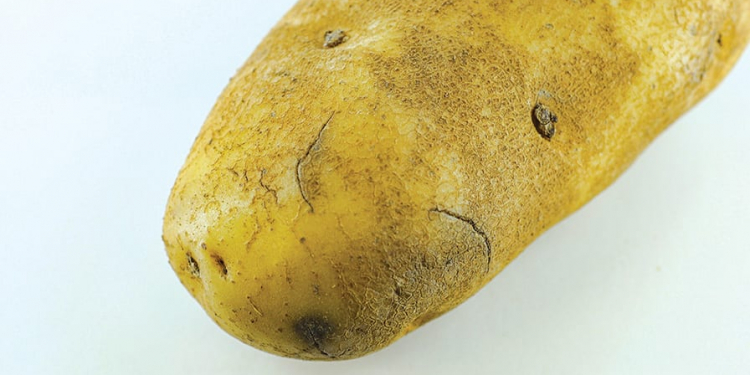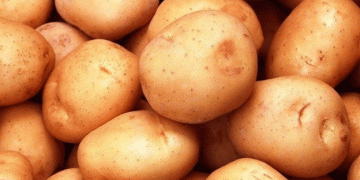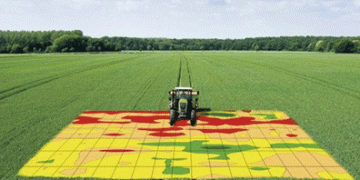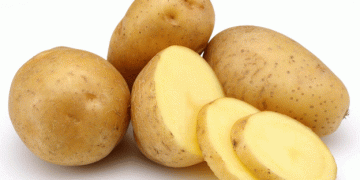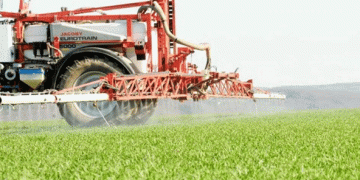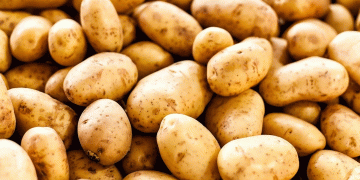If you see cracks and fissures, you know it’s shatter damage. Photo by Rabecka Hendricks.
It’s easy to batter and bruise potatoes during harvest operations. This serious problem costs growers, packers, and processors millions of dollars every year. Let’s look at the most common types of mechanical damage and then tips on how to help minimize damage to your tubers.
How to ID 3 Types of Mechanical Damage
1. Skinning
A good way to identify skinning is to watch for scuffed, scraped, rubbed, and torn off areas of the periderm (skin). You may have heard another term for this: “feathering.” The skinned areas turn dark after a short time, which makes them less desirable for the fresh market.ADVERTISEMENT
It usually occurs when immature potatoes are handled and harvested. The skin on an immature tuber does not adhere tightly to the underlying tissues, which allows the skin to expand with the growing tuber.
The process we know as skin set, where the periderm binds to the rest of the tuber, begins after the vines die and tubers stop growing. Many environmental and genetic factors can influence the time it takes for the skin to set. Excessive nitrogen and potassium fertility delay vine maturation and, even with the help of vine desiccants, can slow skin set.
Some cultivars take longer than others. For instance, red cultivars tend to set skin more slowly than russets. To avoid problems with skinning, vines should be dead or desiccated two to three weeks before harvest to allow time for skin set.
The best way to evaluate skin set is to rub your thumb against the skin to see if it “slips.” If the periderm is easily removed, then you will probably need to give it more time to set before harvest.
2. Shatter Bruise
Shatter bruises occur when the skin splits as a result of impacts. It is characterized by cracks and fissures on the tuber surface. It’s associated with handling tubers that are cold and turgid.
The way to minimize shatter is to avoid excessive soil moisture in the days and weeks leading up to harvest (to limit over-hydration of tubers). Harvest only when tuber pulp temperatures are above 50°F and avoid drops onto hard, unpadded surfaces.
Potato cultivars with high dry matter content tend to be more susceptible to shatter bruise. For cultivars that have a tendency to shatter, it can help to harvest tubers when they are slightly dehydrated.
Read more of Carrie Huffman Wohleb’s Potato Pointer articles.
3. Blackspot Bruise
Blackspot bruising can also result from impacts, but the damage is to cells just beneath the skin. The skin does not break, and there are usually no signs of damage on the surface.
The blackspot bruise develops when damaged cells leak enzymes that react with phenolic compounds to form melanin, a black pigment. The result is a small, gray to black oval area under the skin. It’s a chemical reaction that usually takes about 12 to 24 hours to develop.
It’s also associated with poor tuber hydration, which is just the opposite of shatter bruise. Pre-irrigation before harvest may be necessary to ensure adequate tuber hydration during handling to minimize blackspot. It can take several days to rehydrate tubers in dry soil, so allow several days after irrigation before harvesting.
Tuber size also makes blackspot bruise more likely. It’s associated with large tubers that have high dry matter content and are physiologically old or very mature.
Some cultivars, like ‘Ranger Russet,’ are highly susceptible to blackspot bruise. They should not be allowed to get overly mature, and you should manage soil moisture to ensure adequate tuber hydration at harvest.
General Recommendations
• Harvest tubers when they are mature and have good skin set to avoid skinning.
• It is best to harvest tubers when they are in the range of 50°F to 60°F. Cold tubers are susceptible to both shatter and blackspot bruise. Warm tubers are difficult to cool in storage and are more susceptible to soft rot and other tuber-rotting pathogens.
• An intermediate level of tuber hydration may be best because dehydrated tubers are more susceptible to blackspot, and overly hydrated tubers are prone to shatter.
• Ensure that you adjust and operate harvesting equipment to minimize bruise. Pad conveyor chains with cushioning materials and cushion impact areas. Use devices that minimize tuber rollback on elevators and booms. Adjust the speed of chains and all conveyors to ensure they are filled to capacity (this reduces rollback). Avoid drops of more than 6 inches.
• Know the cultivar you are growing and whether it is more — or less — susceptible to skinning, shatter, or blackspot bruising. Strategies to avoid bruise will vary depending on their relative susceptibilities to bruise.
